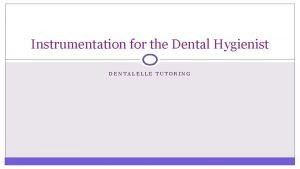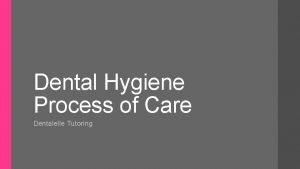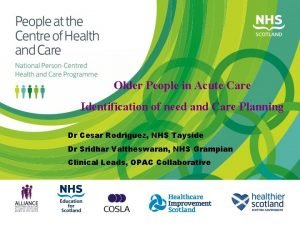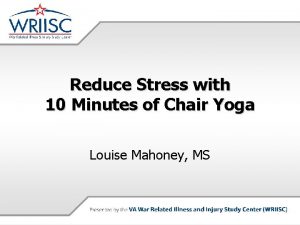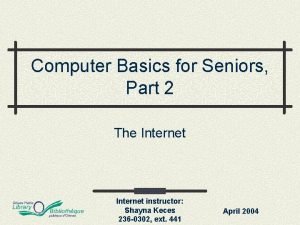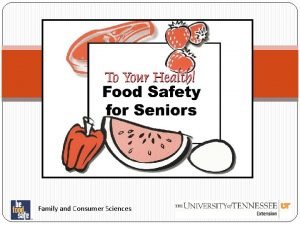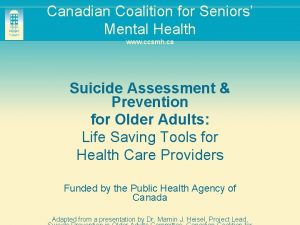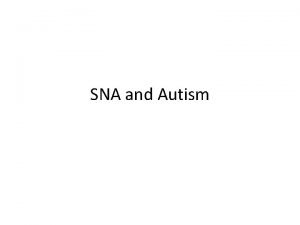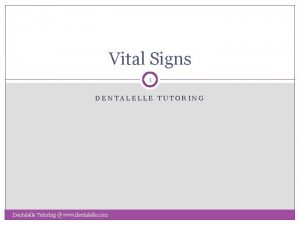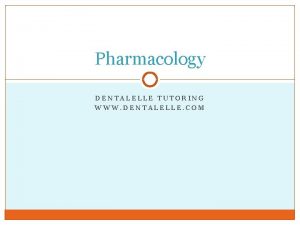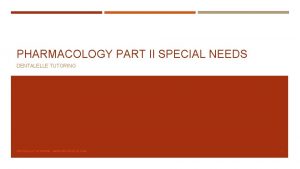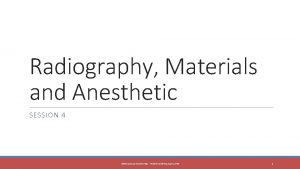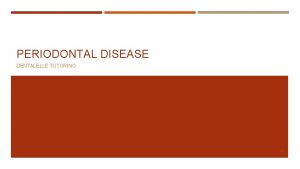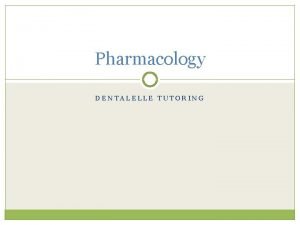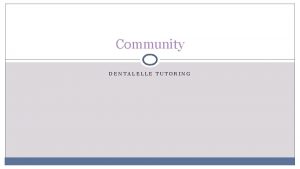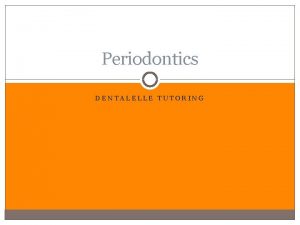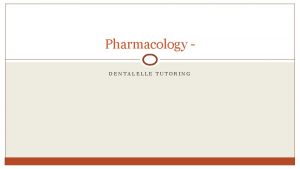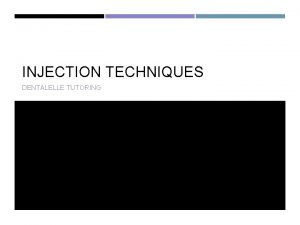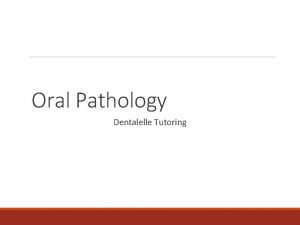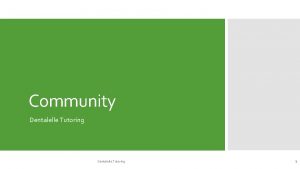Seniors and Special Needs SESSION 3 DENTALELLE TUTORING































- Slides: 31

Seniors and Special Needs SESSION 3 DENTALELLE TUTORING - WWW. DENTALELLE. COM 1

Demineralization occurs when p. H is: A. 5. 0 B. 5. 5 C. 4. 0 D. 4. 4 DENTALELLE TUTORING - WWW. DENTALELLE. COM 2

Answer A. 5. 0 B. 5. 5 C. 4. 0 D. 4. 4 Remember – 7 is neutral. DENTALELLE TUTORING - WWW. DENTALELLE. COM 3

Saliva: A. Aids in remineralisation of teeth B. Provides buffering C. Produces an antimicrobial activity D. All of the above DENTALELLE TUTORING - WWW. DENTALELLE. COM 4

Answer A. Aids in remineralisation of teeth B. Provides buffering C. Produces an antimicrobial activity D. All of the above -- lack of saliva is called xerostomia --a medication that can temp. stop saliva is called ‘Pilocarpine’ DENTALELLE TUTORING - WWW. DENTALELLE. COM 5

What is NOT a retentive carbohydrate? A. Milk B. Chips C. Sour patch kids D. Cookies DENTALELLE TUTORING - WWW. DENTALELLE. COM 6

Answer A. Milk B. Chips C. Sour patch kids D. Cookies *Anticariogenic effect - calcium DENTALELLE TUTORING - WWW. DENTALELLE. COM 7

Which vitamin is NOT fat soluble? A. A B. D C. C D. K DENTALELLE TUTORING - WWW. DENTALELLE. COM 8

Answer A. A B. D C. C D. K Vitamin C is water soluble – A, D, E, K are fat soluble DENTALELLE TUTORING - WWW. DENTALELLE. COM 9

Glucose is the sole energy source for A. Brain B. Kidneys C. Intestines D. Pancreas DENTALELLE TUTORING - WWW. DENTALELLE. COM 10

Answer A. Brain B. Kidneys C. Intestines D. Pancreas Brain AND red blood cells DENTALELLE TUTORING - WWW. DENTALELLE. COM 11

A normal fasting blood glucose level is (mg/dl): A. 50 -90 B. 80 -120 C. 200+ D. 120+ DENTALELLE TUTORING - WWW. DENTALELLE. COM 12

Answer A. 50 -90 B. 80 -120 C. 200+ D. 120+ DENTALELLE TUTORING - WWW. DENTALELLE. COM 13

Numbers above 120 for glucose level could mean: A. Hyperglucose B. Diabetes C. Hyperglycemia D. Ketosis DENTALELLE TUTORING - WWW. DENTALELLE. COM 14

Answer A. Hyperglucose B. Diabetes C. Hyperglycemia D. Ketosis **Numbers below the normal range (80 -120) = hypoglycemia DENTALELLE TUTORING - WWW. DENTALELLE. COM 15

Smooth surface caries are all of the following except: A. Fissures B. Pits C. Roots D. A and B DENTALELLE TUTORING - WWW. DENTALELLE. COM 16

Answer A. Fissures B. Pits C. Roots D. A and B --Smooth surface involves intact enamel surfaces other than pits and fissures --Smooth surface caries are common in seniors (xerostomia), also if the client is going through chemotherapy, radiation therapy, medications that cause dry mouth, antipsychotic meds. DENTALELLE TUTORING - WWW. DENTALELLE. COM 17

What is loss of tooth structure from tooth to tooth contact A. Abrasion B. Attrition C. Erosion D. None of the above DENTALELLE TUTORING - WWW. DENTALELLE. COM 18

Answer A. Abrasion – cervical third Abfraction B. Attrition – incisal edges C. Erosion – chemical wear (most common to be upper anterior lingual) D. None of the above DENTALELLE TUTORING - WWW. DENTALELLE. COM 19

The maximum amount of pressure exerted against the walls of a blood vessel is: A. Radial pulse B. Pulse C. Diastolic pressure D. Systolic pressure DENTALELLE TUTORING - WWW. DENTALELLE. COM 20

Answer A. Radial pulse B. Pulse C. Diastolic pressure D. Systolic pressure Diastolic pressure is the minimum amount of pressure exerted against the walls of the vessels DENTALELLE TUTORING - WWW. DENTALELLE. COM 21

Should the blood pressure cuff be: A. Smaller than the diameter of the arm B. The same size as the arm C. Larger than the diameter of the arm D. Adult size for adults DENTALELLE TUTORING - WWW. DENTALELLE. COM 22

Answer A. Smaller than the diameter of the arm B. The same size as the arm C. Larger than the diameter of the arm D. Adult size for adults **The blood pressure cuff should be 20% greater than the arm DENTALELLE TUTORING - WWW. DENTALELLE. COM 23

Which involves using both hands at the same time at opposite sides of the body? A. Bimanual B. Bidigital C. Bilateral D. Biocclusion DENTALELLE TUTORING - WWW. DENTALELLE. COM 24

Answer A. Bimanual B. Bidigital C. Bilateral D. Biocclusion DENTALELLE TUTORING - WWW. DENTALELLE. COM 25

What happens when there is a decrease in blood pressure? A. Exercise B. Eating C. Oral contraceptives D. Syncope DENTALELLE TUTORING - WWW. DENTALELLE. COM 26

Answer A. Exercise B. Eating C. Oral contraceptives D. Syncope – fainting DENTALELLE TUTORING - WWW. DENTALELLE. COM 27

If a client is hyperventilating what do you do? A. Breathing into cupped hands B. Administer Oxygen C. Supine Position D. Subsupine position DENTALELLE TUTORING - WWW. DENTALELLE. COM 28

Answer A. Breathing into cupped hands B. Administer Oxygen C. Supine Position D. Subsupine position AND tell the client to breath deep, remain calm . DENTALELLE TUTORING - WWW. DENTALELLE. COM 29

A diabetic is most commonly to experience: A. Hyperglycemia B. A lost limb C. Eye issues D. Hypoglycemia DENTALELLE TUTORING - WWW. DENTALELLE. COM 30

Answer A. Hyperglycemia B. A lost limb C. Eye issues D. Hypoglycemia DENTALELLE TUTORING - WWW. DENTALELLE. COM 31
 Instrument grasp in dentistry
Instrument grasp in dentistry Adpie dental hygiene
Adpie dental hygiene Primary needs and secondary needs
Primary needs and secondary needs Primary needs and secondary needs
Primary needs and secondary needs Alpha press murray
Alpha press murray Strategic gender needs and practical gender needs
Strategic gender needs and practical gender needs Wants in esp
Wants in esp Special educational needs and disability act 2001
Special educational needs and disability act 2001 Savvy saving seniors
Savvy saving seniors Identification of seniors at risk
Identification of seniors at risk Dutchtown high school seniors
Dutchtown high school seniors 2812840027
2812840027 Seated triangle pose
Seated triangle pose Park place seniors living reviews
Park place seniors living reviews Momiji health care society
Momiji health care society Pps humour seniors
Pps humour seniors Welcome back seniors
Welcome back seniors Internet basics for seniors
Internet basics for seniors Cycling seniors
Cycling seniors Writing prompts for seniors
Writing prompts for seniors Food safety for seniors
Food safety for seniors Canadian coalition for seniors mental health
Canadian coalition for seniors mental health Project based learning for students with special needs
Project based learning for students with special needs Elderplan plan materials
Elderplan plan materials Teachwise
Teachwise Friends of children with special needs
Friends of children with special needs Virginia special needs trust
Virginia special needs trust Colorado special needs trust
Colorado special needs trust Instructional adaptations for special needs students
Instructional adaptations for special needs students Castlewood primary school
Castlewood primary school Role of an sna for a child with autism
Role of an sna for a child with autism European agency for development in special needs education
European agency for development in special needs education
